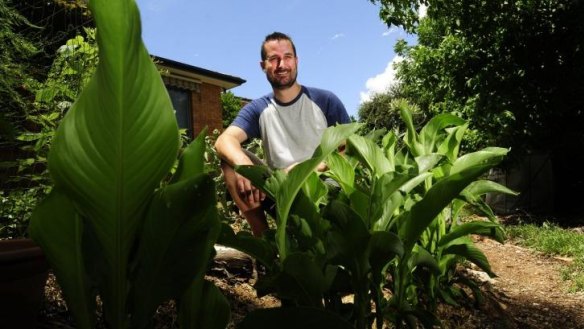Susan Parsons: Why Benn Sutcliffe is the mulch king of Latham in Canberra

A saxophonist who doesn't like gardening blows our way into the new year. Benn Sutcliffe, with his wife Kristin, creates a musical family that lives in Latham. He teaches clarinet and saxophone and plays with a number of local groups but the sax was quiet on our visit as one of his young children was asleep.
Five years ago his front yard was all lawn. He mulched half of it with a few hundred square metres of recycled cardboard, about 300 bags of oak leaves from the Ainslie Arts Centre, around 100 bags of coffee grinds from local cafes, grass clippings from his neighbours and from the laneway across the road (which he mowed), plus a load of lucerne. Mulch 30 centimetres deep turned into a first layer of real soil five millimetres deep and into that he sowed green manure and some pioneer crops. Among them was wild buckwheat which is good for the soil and also a bee attractor. He now has more than 100mm of amazing soil in places.
Benn says his garden is a long-term experiment. He tries different things each year and how much he plants depends on his schedule but it is mainly inspired by permaculture and Jackie French's book The Wilderness Garden (French is a gardening columnist for Canberra Times' Relax magazine). No matter what he plants, it gets heavily mulched and fed each year and he has never had to weed the front yard garden and it has never been dug.

At one point he was making about 12 cubic metres of hot compost at a time but it was too labour intensive with young children around so his main source of fertiliser is seven worm farms, some of which are built into the ground, some of which are mobile. At present he has a worm farm made from broccoli boxes.
Benn says he can't stand double handling so, early on, he rejected the more usual worm farm sold by garden centres. He uses autumn leaves from his trees each year and owns a huge mulcher to recycle all of his prunings. There is one compost bay and he makes a proper batch each year. Masses of comfrey are planted next to every fruit tree and grown to use as mulch in summer. Comfrey is a micro nutrient accumulator, says Benn, and is also used to make garden tea, a liquid fertiliser.
An edible plant in his garden that Benn calls "particularly cool" is Queensland arrowroot (Canna edulis). Benn says the tuber is a carbohydrate staple (tapioca flour) or can be sliced into chips and fried or grated for fritters. He slices and soaks the rhizome in water for 20 minutes to remove excess starch.

The growing area is not vast but, due to rich soil, it can be planted very tightly and Benn likes to create micro climates within the garden to allow unusual plants to grow. We walked along narrow paths past bronze and wild fennel, warrigal greens, rhubarb, jerusalem artichokes, borage, tarragon, parsley and Peruvian ground apple (yacon). The asparagus patch provided such a good crop they were giving spears away.
Then I spied a species of santolina. It was the olive herb (S. rosmarinifolia) which a pal had recently bought with some excitement at the Melbourne Garden Festival. Olive herb is a cold and drought hardy perennial and the leaves have a strong aroma of olives. Benn says in spring you would swear you were eating an olive. During summer it smells more like pine and the yellow button flowers are a bee forage.
A pair of globe artichokes were divided and more planted to create an impenetrable hedge as a windbreak. Just before Christmas they were coming into flower. There are black currants, jostaberries, blueberries, wolf and goji berries, gooseberries, youngberry, strawberries, raspberries, lemons, oranges, limes, pomegranate, persimmon, crab apples, cherries, feijoa, loquat and olive trees.
Five years ago, with one of his students who was getting into gardening, Benn traded heads of Patrice Newell's purple garlic for a small fig tree. The family makes a pickle from their wild fennel and garlic, chilli and olives.
Various protector plants or bee attractors include lavender, rue, tansy and vetch. There is lemon balm, valerian, lemon verbena, oregano, chives, sage, thyme, lovage and dandelion greens. Some plants like dill, coriander and parsley are wasp attractors that eat wasps off citrus. A favourite plant is a white moscato grapevine given to Benn by an old Croatian bloke up the road.
Yet, despite all these edible plants, Benn says the best thing about a garden is to sit under a shady tree and relax among the bounty.
Susan Parsons is a Canberra writer.
Restaurant reviews, news and the hottest openings served to your inbox.
Sign up